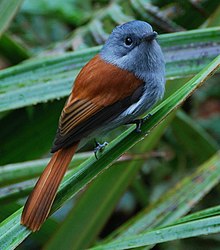Terpsiphone
| Paradise flycatchers | |
|---|---|
 |
|
|
Mascarene paradise flycatcher Terpsiphone bourbonnensis |
|
| Scientific classification | |
| Kingdom: | Animalia |
| Phylum: | Chordata |
| Class: | Aves |
| Order: | Passeriformes |
| Family: | Monarchidae |
| Genus: |
Terpsiphone Gloger, 1827 |
| Species | |
|
see text. |
|
| Synonyms | |
|
|
see text.
The paradise flycatchers (Terpsiphone), are a genus of bird in the family Monarchidae. The genus ranges across Africa and Asia, as well as a number of islands. A few species are migratory, but the majority are resident. The most telling characteristic of the genus is the long tail streamers of the males of many species. In addition to the long tails the males and females are sexually dimorphic and have rufous, black and white plumage.
The genus Terpsiphone contains sixteen extant species:
Formerly, some authorities also considered the following species (or subspecies) as species within the genus Terpsiphone:
The paradise flycatchers are generally small birds, around 18 to 21 cm (7.1–8.3 in) in length and weighing 12 to 23 g (0.42–0.81 oz). They have a medium length grey or blueish bill which is broad and hooked at the end and is surrounded by stiff rictal bristles. The inside of the mouths of paradise-flycatchers are brightly coloured, being either yellow or green. The tails are long, particularly in many species where the male has a massively elongated pair of middle tail feathers. These tail streamers are 195 mm long in the male São Tomé paradise flycatcher and 412 mm long in the male Indian paradise flycatcher. The function of the long tail is assumed to be related to sexual selection, with females choosing males based on the length of the tail. Not all species have long tail streamers, for example the blue paradise flycatcher of Palawan in Asia and the Bedford's paradise flycatcher of montane Africa do not have exceptionally long tails. In most species the tail is longer than the wing, even in the shorter tailed females. The eye is surrounded by an eyering that is a blue thin wattle (slightly more pronounced in some species like the rufous paradise flycatcher).
...
Wikipedia
